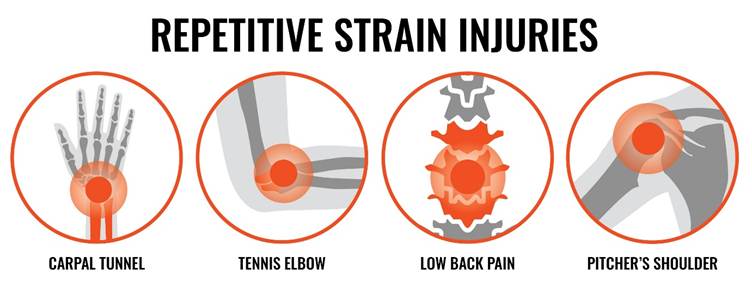In today’s digital world, Repetitive Strain Injury (RSI) is becoming increasingly common—not just among athletes or factory workers, but also in office-goers, students, and homemakers. RSI refers to pain and discomfort caused by repetitive movements or overuse of certain muscles and tendons, often without enough rest or proper posture.
What Is RSI?
RSI is an umbrella term for a variety of musculoskeletal conditions that result from repetitive motions, vibrations, or forceful exertions, especially over long periods. It typically affects the hands, wrists, elbows, shoulders, neck, and upper back.
Common Activities That Can Lead to RSI
- Typing or using a computer mouse for extended hours
- Texting or scrolling on mobile devices
- Repetitive lifting or twisting motions
- Poor posture while sitting or standing
- Playing musical instruments or video games
- Sports involving repetitive arm or leg movement
Who Is at Risk?
You may be at increased risk of RSI if you:
- Work at a desk for long hours without breaks
- Frequently use handheld devices or keyboards
- Perform repetitive manual tasks (e.g., packing, painting)
- Use poor ergonomics or sit with bad posture
- Have a high-stress job with little physical variation
Common Symptoms of RSI
RSI symptoms usually develop gradually and may include:
- Pain, aching, or tenderness in muscles or joints
- Tingling or numbness (often in hands or fingers)
- Weakness or fatigue in the affected area
- Cramping or throbbing sensation
- Stiffness and reduced range of motion
Prevention Tips
- Take Regular Breaks
- Follow the 20-20-20 rule: Every 20 minutes, take a 20-second break and look 20 feet away.
- Maintain Good Posture
- Sit up straight with shoulders relaxed and back supported.
- Keep wrists in a neutral position while typing.
- Use Ergonomic Tools
- Invest in ergonomic chairs, keyboards, and mouse pads with wrist support.
- Stretch & Exercise
- Perform hand, wrist, and shoulder stretches regularly.
- Strengthen muscles with light resistance exercises.
- Listen to Your Body
- Don’t ignore early signs of discomfort. Rest is important for recovery.
Treatment Options
Non-Surgical:
- Rest and activity modification
- Ice packs to reduce swelling
- Anti-inflammatory medications (NSAIDs)
- Physical therapy and ergonomic training
- Splints or braces to reduce strain
Medical Intervention:
- In severe cases, corticosteroid injections or surgery may be considered.
Conclusion
Repetitive Strain Injuries are highly preventable if recognized early and managed properly. Whether you work at a desk, on a production line, or at home, being aware of your movement patterns and posture can significantly reduce your risk. Don’t wait for the pain to become unbearable—prevention is the best cure.
Disclaimer: This blog is for educational purposes only and is not a substitute for professional medical advice. If you are experiencing persistent pain or discomfort, consult a healthcare provider.
